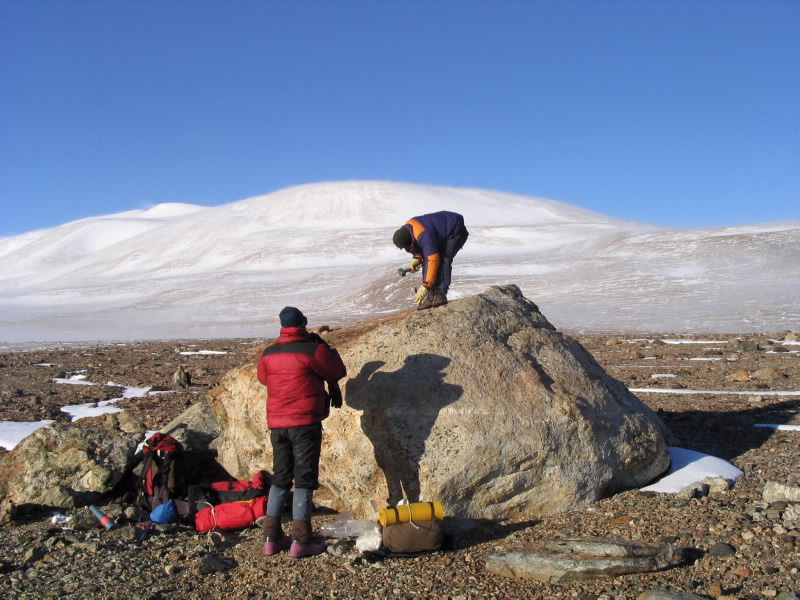Research conducted on ice from the margin of Greenland's ice sheet revealed that a vast, potential source of the potent greenhouse gas, methane, is more stable in a warming world than previously thought.
 |
The ground breaking research, published in the journal Science, involved a team of scientists from Denmark, New Zealand, United States and Australia's CSIRO and ANSTO.
Greenland is a place we've all heard of and, for some, conjures up pictures of Santa and his herd of reindeer, led by happy, red-nosed Rudolf. It's a great land of ice and snow, with just a touch of fantasy. But for scientists it's an Aladdin's cave, holding important climate change secrets embedded in its ice.
Greenland is the world's largest island and is rather oddly named since over 80 per cent of its surface is covered by a thick sheet of white ice and snow. A part of the Kingdom of Denmark, located between the Arctic and Atlantic Oceans, Greenland's ice recently delivered some 'good news' for Earth's future climate.
When the average person thinks of methane, it's the burps and farts of animals and humans that probably spring to mind. These unwelcome emissions are important, but, it's predominantly wetlands in the tropics and those emerging from beneath receding Northern Hemisphere glaciers which are considered the primary source of rising atmospheric methane in a warming world.
Scientists also know of another potential source, with the potential to vastly increase the greenhouse effect, and which has triggered considerable debate.
Massive quantities of methane are locked away in permafrost and in the Earth's ocean floors as methane clathrate - an ice-like material which can return to a gas if temperatures increase or pressures drop.
There is several thousand times as much methane locked up as icy methane clathrate as there is gaseous methane in the atmosphere. And it's potent - over a hundred year period it is 25 times more effective, kg for kg, than carbon dioxide as a greenhouse gas.
Scientists say that if a mere 10 per cent release of this methane took place it would have the equivalent impact on global warming of a ten-fold increase in carbon dioxide concentration.
So began this important research to understand ice core records spanning hundreds of thousands of years, profiling periods of high-methane increase and focusing on the end of the Younger Dryas period - a period known as the Big Freeze - which occurred 12,000 years ago.
At the end of the Younger Dryas there was a 50 per cent increase in atmospheric methane when the Earth warmed and scientists needed to know where this methane came from. Was it from wetlands or was it from methane clathrate at the bottom of the ocean? If it was from methane clathrate, could it happen again and would it be worse?
The research has brought some relief to the Earth's climate predictions.
"The result is a good news outcome for climate scientists monitoring greenhouse gases and investigating the likely sources of methane in a warming world," said CSIRO's Dr David Etheridge, from the Centre for Australian Weather and Climate Research, who helped show how air could be extracted from polar ice to measure past methane changes and identify their causes.
"There are vast stores of methane clathrates beneath the ocean and in permafrost and there is evidence that many millions of years ago release from these storages caused significant climate change, although none in more recent times.
"The objective of the research was to determine how stable the clathrate methane stores were as the Earth warmed rapidly from its last glacial state and whether clathrates might be a source of future climate change as global temperatures rise," said David.
ANSTO's Dr Andrew Smith studied the source of the methane by using a technique called accelerator mass spectrometry used to detect individual radiocarbon atoms from ancient atmospheric methane samples over the Younger Dryas period.
"Radiocarbon provided the key insight to decide whether the extra methane was derived from clathrates or from wetlands," Andrew said.
The project involved years of field-work in West Greenland where scientists accessed samples located in 'outcropping' ice, a cross-section of ice formed over tens of thousands of years that is exposed at the surface.
"We needed a lot of ice to do the research and a tonne was excavated to provide sufficient air from bubbles trapped in the ice for each measurement of the methane carbon isotopes," said Andrew.
Extremely sensitive analysis was required because of the low concentration of methane in air and because only about one trillionth of that methane contains radiocarbon - the carbon-14 isotope (C14) is the key indicator of clathrate emissions. The analysis was undertaken on one of ANSTO's particle accelerators located on its site in southern Sydney.
The absence of methane C14 isotope change accompanying the jump in concentration confirmed that the emission was not from clathrates, but from ecological sources such as wetlands.
"We know that emissions of methane are increasing now and that some sources might emit even more with warming, causing a positive climate feedback, or amplification. But this finding suggests that the clathrate source is less susceptible than recently feared," Dr Smith says.
We can therefore rest easy now we know that at least one potent greenhouse gas is no longer considered such a major ticking time bomb on our ocean floors.
The Centre for Australian Weather and Climate Research is a partnership between CSIRO and the Bureau of Meteorology.
Published: 21/06/2009


